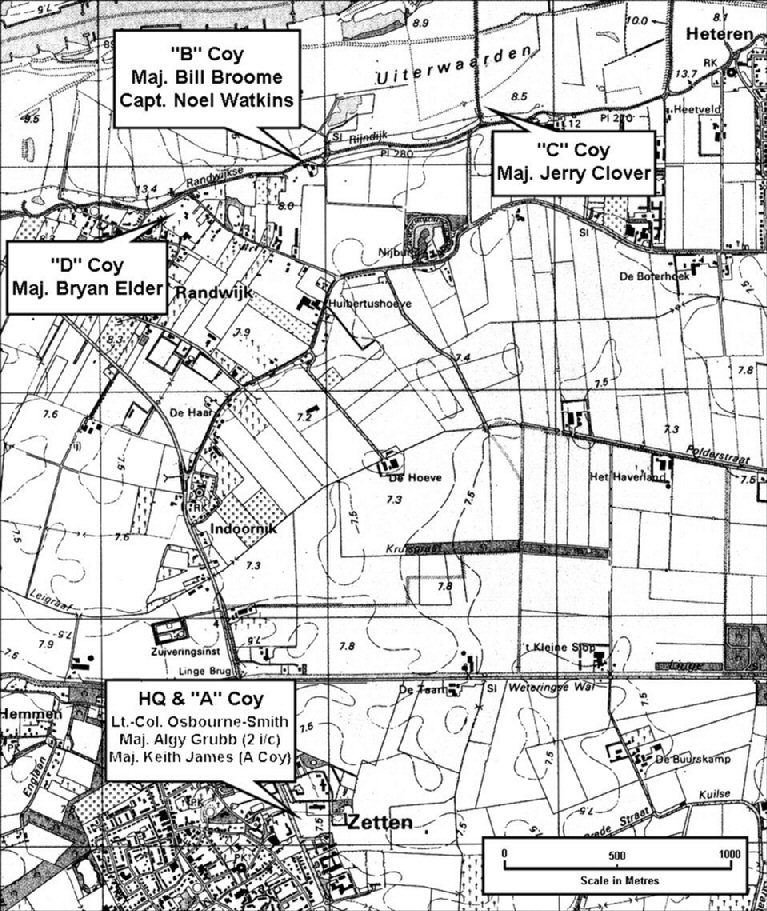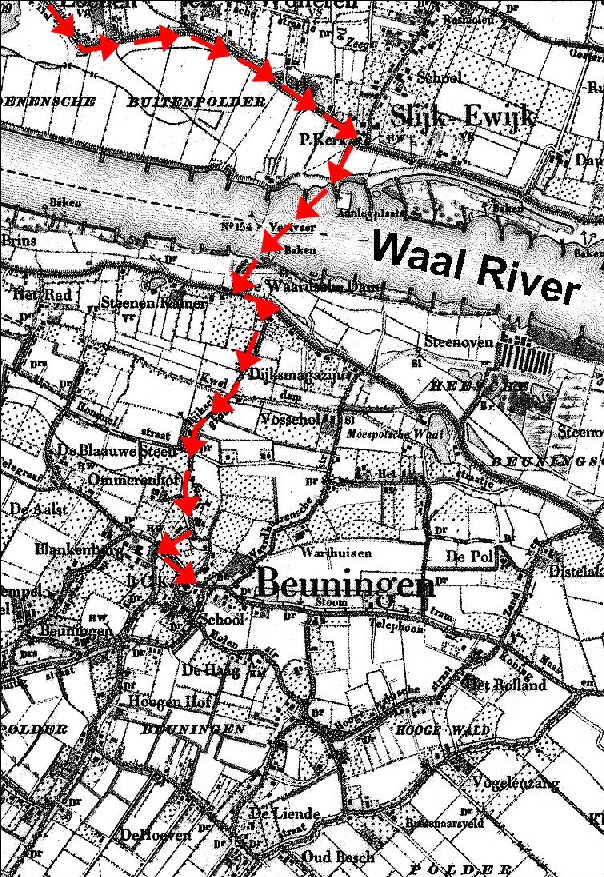Randwijk (September 1944)
The village of Andelst lies roughly one mile north of the River Waal and seven miles west of Nijmegen, and consists of a straggling but picturesque collection of small modern farms. It was here on the 26th September, after being relieved by the 4th Somersets and the 4th Witlshires that the Worcesters repaired and rested after the battle for Elst. The loss of two able Company Commanders killed in action was greatly felt. It was a sad blow to the Battalion. Major M. M. Souper, who had commanded ‘D’ Company since early Normandy, was a man of great charm, ability and personal courage, while Major M. A. Gibbins, although he had only joined the Battalion at Berjou and commanded ‘A’ Company since the Seine, had shown more than average ability and initiative. They were succeeded by Major B. R. N. Elder and Major K. R. H. James respectively. Alas, they were not to be the only officer losses of this period.
On the day following their arrival in Andelst (27th September) the Worcesters were again called from their orchards and barns, for at 15.00 hours they were ordered to be prepared to take the field once more, this time to aid the 7th Somersets who were reported to have located enemy in their area to the north. Their column, including a Squadron of Shermans, formed up on the road and cocked its ear to the sound of battle in front where the heavy “crump” of 4.2 mortars was easily distinguishable. As they waited the rain fell in torrents and it was not until they were all thoroughly drenched that they were ordered to stand down with the exception of ‘C’ Company, the leading Company, who were sent forward to take up a position on the level-crossing 1000 yards south of Zetten. This, however, proved to be a mistake; they were withdrawn later that evening and retired to their original position. The next day (28th September) at 16.00 hours the 1st Worcesters relieved the 7th Somersets (who had mopped up in the river area on the Neder Rijn the previous day, taking 145 P.O.W). The 7th Somersets had three Companies on the line of the dyke road overlooking the Neder Rijn in the area of the village of Randwijk. The relief was completed by 21.00 hours with Worcestershire ‘C’ Company on the right, ‘B’ Company in the centre and ‘D’ Company on the left. ‘A’ Company and Battalion H.Q. were back in the area of Zetten. However, this simple operation was not carried out without a mishap; the Pioneer Platoon Sergeant (Sergt. Priest) whilst travelling in a jeep ran over a 75 anti-tank mine and had to have his foot amputated as a result. The 7th Somersets withdrew to a rest area at Zetten—Andelst. |
Major K. R. H. James |

1st Battalion Worcestershire positions on 29th September 1944
Sergeant Jim Norton recalls; Everywhere was very quiet (except for the noise of my motor bike), and when I reached the bridge where the platoon had established its HQ, it was deserted! I went on foot to the top of the dyke, which carried the road and looked across the open country. It was deserted! I decided to get back on my bike and beat a hasty retreat! About half a mile back a sentry stepped into the road. I was very relieved that it was one of our lads! They had seen me go through but had been unable to stop me! They told me, (optimistic as ever), that they had been expecting that I would return. The enemy had withdrawn after inflicting heavy casualties, which included the Company Commander. My signallers, seeing the section they were with being overrun, grabbed the telephone and ran. They then re-connected the phone to the line further back and were already in communication with Battalion HQ when I located them.” During the night there was much patrolling but the enemy was nowhere engaged. Worcesters Pioneer Officer (Lieut. Allum) went forward escorted by a patrol from ‘C’ Company and laid some booby-trapped 36 Grenades on the riverbank at the approach to the Ferry. At dawn next morning (29th September) the Worcesters saw the Neder Rijn for the first time from the dyke road which runs roughly parallel to it; open fields, rich and alluvial, sloped gently down to the water—a matter of approximately 500 yards, offering a magnificent field of fire to the defenders and only suicide to any attackers choosing to come that way. |
Sergeant Jim Norton |
Captain Noel Walkins |
That morning the Germans continued to shell intermittently the area the Worcesters occupied. At this time ‘B’ Company HQ was in a farmhouse named “Notenboom” (translated Walnut Tree), about 1000 yards west of Randwijk. The Company Commander Major Bill Broome, Captain Noel Walkins (2 i/c) and a signaller were standing in the kitchen of the farmhouse when 88 mm shell came through the window and exploded mortally wounding Major Broome and killing outright Captain Watkins and the company signaller Private Fred Marsh (see location map above). Lieutenant Rex Fellows recalls the incident well; “ I remember speaking to Bill as they carried him out on a stretcher and thinking to myself a need to seek revenge” This made the total loss of officers in that week to four, three Company Commanders and one Company Second-in-Command. Major A. A. Grubb, who had been acting Second-in-Command of the Battalion, went forward and took command of ‘B’ Company. |
Major W. Broome |

“Notenboom” farmhouse (arrow showing window the shell hit)
A Gunner F.O.O. (Captain Roy Woodward) went forward and established himself on the dyke but, although he was always a comfort to have around, on this particular occasion the ammunition supply was so very limited owing to the fact that the supply-route was frequently being cut between Graves and Eind¬hoven, that he could do very little in the way of retaliation. At one time the ammunition supply fell to as little as three rounds per gun per day. Nothing else worth recording happened during the day, but that night the 3-in. Mortar Platoon played havoc with the enemy’s back areas across the river.
The next day (30th September), at 19.00 hours to everyone’s surprise, the Worcesters were relieved again by the 7th Somersets, and withdrew to an area of south of Zetten. The relief was completed by 21.45 hours and the Worcesters billeted themselves on the local populace with Battalion Headquarters at Zetten and Andelst Railway Station.
It was during this period of “rest” that a party of German “Frog Men” swam five kilometres down the River Waal propelling two marine torpedoes and neatly blew the centre span out of the river railway bridge at Nijmegen. This act cost them their freedom for they were all taken prisoner, but at the same time it was no mean feat and would have proved very embarrassing for the forces on the “island” had they succeeded in doing likewise to the road bridge, probably their original intention. As it was the road bridge was damaged but remained serviceable, though still under heavy shellfire, and the life-line remained open. After this episode the two bridges and the stretch of river, which flowed through the town, were floodlit at night by searchlights. The Germans made frequent attempts to blast the road bridge from the air, and regularly by last light two or three sneak raiders would come singly and drop one bomb in an attempt to isolate our forward troops. These aircraft were always met with a solid wall of anti-aircraft fire, and although only a few were shot down it served to put the enemy off his line. Despite numerous near misses, the bridge remained untouched.
|
On the 1st October the announcement “No move to-day” was followed closely by the order “Battalion at five minutes’ notice to move”—by no means an unusual occurrence—and shortly afterwards, when the order to move was received, the Worcesters were formed up on the road, piled high on carriers, tank gun-towers and other Battalion transport. It appeared that a threat had developed on the right in front of the Armoured Guards and they were required to whip back down to Oosterhout and to remain there as reserve Battalion. The day was spent in digging slit trenches, eating pears and talking to the Dutch people, and the peace was undisturbed; towards mid-afternoon the threat seemed to have vanished and they marched the seven miles back to our original billets in Zetten. The next day (2nd October) was quiet except that at about midday, to everyone’s intense annoyance, the area was quite severely shelled. ‘Sp’ Company H.Q. had several direct hits and a chunk of falling masonry hit Lieut. R. Brown (Carrier Platoon Commander) on the head, but did him little harm. Apart from that there were few casualties despite the fact that the Battalion were living above ground. |
On the 3rd October, orders arrived to relieve 4th Wiltshires in the area approximately two miles east of Valburg with one Company forward in the south-west corner of Elst. The relief was completed by 20.00 hours, ‘C’ Company taking over from the forward Company.
The Worcesters remained there during the 4th and 5th October and, although nothing very much happened, the usual “alarms and excursions” filtered back from the more forward areas. They were shelled spasmodically, but quite ineffectively, and the War Diary records that on the 3rd October a Dutch wife of an S.S. Officer was picked up and evacuated from the Battalion area for her own safety.
On the 6th October, most of the British troops were withdrawn unlamenting from the “island”, and it was taken over by the 82nd American Airborne Division. The Battalion, preceded by its usual recce party, made its way back to the area of Beuningen (known by the Worcestershires as Brummagum) on the south bank of the Waal, being ferried across the river in D.U.K.W.S. from a point on the north bank near Slijk Ewijk (see route map below).
Beuningen was only sparsely furnished with houses, again of the small farmstead variety, and these were greatly overcrowded with evacuees from Nijmegen. Companies therefore had to put up with barns and haylofts and somewhat cramped conditions, as the weather was now getting too cold for sleeping out in the open unless operational necessity dictated.






